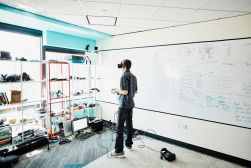Arizona State launches virtual wildlife sanctuary for biology students

Arizona State University has begun developing new immersive locales using virtual reality, starting with a virtual wildlife sanctuary for biology students.
Through a partnership announced last week with the virtual reality company Dreamscape Immersive, ASU leaders said they aim to make online classes more engaging, creating an immersive educational experience for students while they are learning remotely during the pandemic. Starting with introductory biology, and eventually expanding to more courses, the tools are designed to allow students to explore and engage with virtual worlds as an avatar in a game-like learning system. University leaders said the tool aims to prepare students for 21st century careers and help eliminate learning gaps as they apply their skills and knowledge to solve real-world problems in a more hands-on way.
“We’ve always known there is huge potential to unlock new learning realms for students by merging VR — and all that it empowers educationally and socially — with advanced, adaptive educational experiences,” ASU President Michael Crow said in a press release. “Through Dreamscape Learn, students of all ages will be able to explore completely different worlds and perform complex learning, discovery and problem-solving tasks that you wouldn’t be able to do in a traditional learning environment or lab in a campus setting.”
The first immersive course for introductory biology will transport students to a wildlife sanctuary for endangered life forms where they will be able to explore, observe and collect digital specimens and solve problems to key concepts in introductory biology, such as treating infectious diseases, managing genetic diversity and balancing food webs.
The VR course in biology is expected to be available to students in 2021 and is slated to expand to other subjects by 2022.
Other higher education institutions have also turned to VR technology during the pandemic. California Community Colleges in April created a virtual science labs for biology, chemistry, physics and general sciences, allowing students to apply their learned knowledge in controlled scenarios that typically require in-person class time.
Similarly, at University of North Carolina at Chapel Hill, a professor at the Hussman School of Journalism and Media, developed the virtual classroom for his “emerging technologies” class to help students interact with each other despite not physically being in class together.
Rutgers University has also turned to VR with its new virtual spaces that give students an immersive way to learn as an alternative to simply having discussions through video conferencing.




